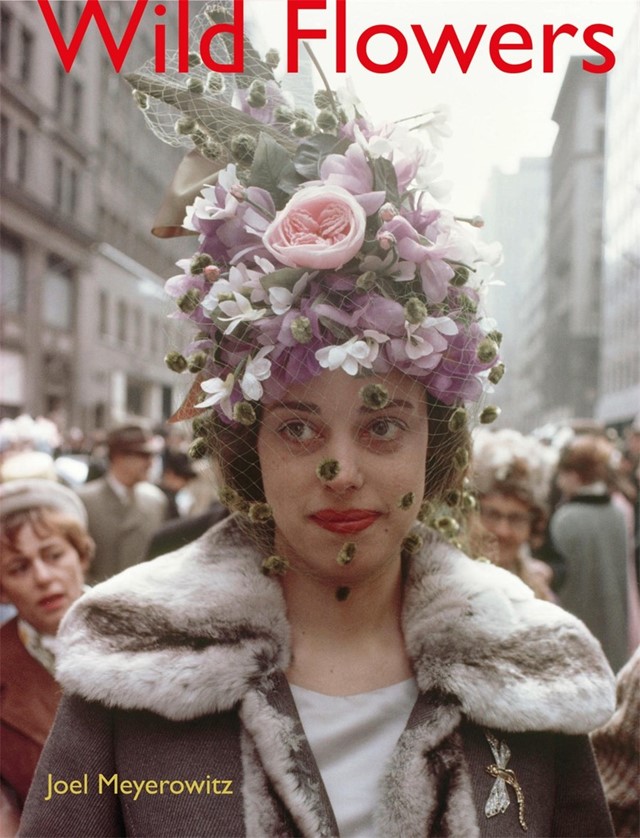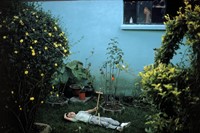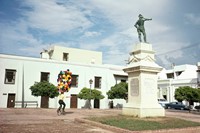Speaking to Belle Hutton, the photographer shares the stories behind seven of the photographs in a new edition of his 1983 publication Wild Flowers
“I had hoped that under the umbrella title of flowers, all of life could be offered up,” says Joel Meyerowitz, explaining the sentiment behind his newest publication Wild Flowers. Though the book is only new to an extent: published by Damiani, this edition of Wild Flowers is an edited and updated version of Meyerowitz’s 1983 publication, his third book which has become something of a classic in the decades since. Spanning street photography, portraits, still lifes, landscapes, cityscapes and more, Wild Flowers brings together photographs from Meyerowitz’s entire career, from 1967 to 2020, all of which are floral in varying ways. “I like the way it feels now. It feels more like the me that I am now, rather than the me that I was 30-something years ago,” Meyerowitz says over Skype from his home in Tuscany.
When Meyerowitz published the original edition of Wild Flowers, it was a departure from his two previous books, Cape Light and St Louis & the Arch, which were filled with photographs made using a view camera. “I remember thinking that it was kind of ballsy of me at the time, after making two books with the large format camera which were kind of sensual and serious and about space and light and other photographic subjects, to turn around and do this,” he laughs. The idea for Wild Flowers was something Meyerowitz came upon by chance when looking through his archive in the late 1970s and noticing this subtle recurring motif. “After a few hours of research I had like 50 pictures in which the flower played a role,” he says. “Not necessarily a beautiful picture of a flower but something in which the subject of the flower brought them all together and it tied up a bunch of disparate subjects. And at the same time I thought, ‘God the flower is such a cliche. Wouldn’t it be interesting to challenge the cliche and see if I could not show pretty pictures of flowers?’”
As with the original, the updated edition of Wild Flowers – in which photographs have been both added and removed, and is printed in a larger format – covers the unexpected joy, chaos, sadness, beauty and humour that life presents, and central is the vivid street photography that Meyerowitz is renowned for. “There’s such a range to the way the flower works its way into our everyday life, offering me an opportunity to look at life from an oblique angle. We’re all embroidered into this tapestry, into this bouquet of life,” he says. “We take flowers for granted or we celebrate them as exquisite beauties, but they’re more than that – they’re part of the daily vocabulary of seeing. The flower plays a larger role in our lives and I just thought I’d celebrate that.”
Here, Meyerowitz shares the stories behind seven of the photographs in Wild Flowers.
Paris, France 1967
“This was 1967, and I lived in Europe for a year. I travelled to Paris and stayed for a couple of months and I was just out everyday, wandering the city. During that year I shot 700 rolls of film and I really learned to be who I am. I was walking through the Jeu de Paume in Paris and it was springtime and the gardens were full, and I saw this woman walk into the frame carrying these yellow flowers. Behind her was this whole fountain full of yellow flowers, and for a brief second she looked like she was in camouflage. Then I saw this crazed statue of Pan playing his flute in the forest and sort of skipping over her. The fact that it was layered with flowers and that she became slightly dissolved in the image – that was part of the visual delight for me.”

Longchamps, Paris 1967
“I learned as a street photographer how to become invisible. It’s an asset you have to develop if you want to survive in that kind of jazz-like moment. This is during that same year in Europe. We went to the horse races at Longchamps and there were people wearing top hats and waistcoats and tuxedos and morning clothes – the most beautiful spring-like outfits. There were flowers everywhere, all these carnations. As I was on this deck, a sudden gust of wind came and blew one of the hats off just where I was standing. These four women were all in this wonderful kind of ballet, with onlookers everywhere. At first I was only watching all the pomp of it, as they all parade around, and then nature comes along and throws rain or wind or dust on you, and you see the poise unsettled for a moment.”
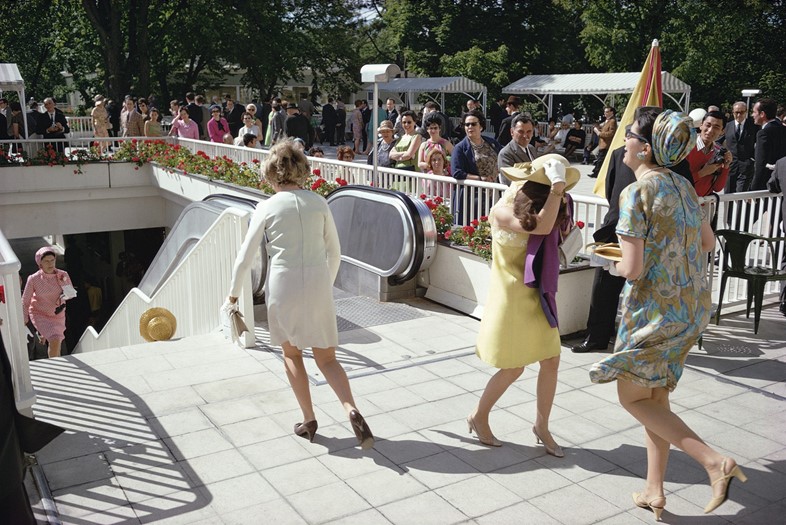
San Cristobal de las Casas, Mexico 1971
“I was on a trip to Mexico and I was deep into the southernmost part of the country. I was walking through a little village and I looked into a garden, and here was this boy with his makeshift sword. He was lying on the ground holding his sword like a King Arthur knight having fallen. It also looked like a cross, so for a split second he was both crusader and knight. The colour is so overwhelmingly delicious, and the gesture and the flowers. I think part of my method is that if something gives me this little kick of a story, this little tingle, I go with it. That spark that happens between reality and ambiguity, that buzz, is what makes photography special to me. You’re being given a fact, but the fact is slippery. Everything in the photograph is live matter.”

San Juan, Puerto Rico 1974
“This is in San Juan, Puerto Rico. I was on assignment to do an advertising campaign to show the beauty of Puerto Rico. On the day I got there, the art director and I did a scout. While we were in this little plaza a man on a unicycle passed through – he was there for 15 seconds maybe. I made two or three pictures as he came through, carrying on his head a gigantic tower of handmade paper flowers with that one hand balanced, in a similar pose as the statue. I couldn’t have dreamed that up or invented that. That’s what’s so wonderful about life, is that the most unexpected things happen and if you don’t have a camera, nobody knows.”

Table, Provincetown 1983
“This is on Cape Cod in the 80s. I lived on the water then, and we had dinner with the people next door that night and we were all sitting outside until midnight, and then the tide was high and we all went for a midnight swim. In the morning I got up just at sunrise, and the morning dew was on all the glasses and the petals had fallen off onto the table. It was like a still life made by eight people, and seeing it at sunrise with the mist on the water and this bouquet of roses that grow on the dune grass was such a joyous moment. I felt that that is the same kind of sensibility that I use on the street. I take it for what it is, I don’t arrange it.”

Ceremony, Cape Cod Bay 2010
“One of my best friends, Jim Wood, was the president of the Getty Foundation. We met in St Louis when he was director of the St Louis Art Museum – he commissioned me to do my book St Louis & the Arch. Suddenly, after visiting with me here in Tuscany in 2010, he went back to America to the Getty and died just like that, two weeks later. A few months later we spread his ashes on the sea where he was born outside of Cape Cod in Boston. There’s this incredible gesture of a flying flower and kissing a flower and holding a flower – all of this seemed to me something that should be in the book. That it should be all of life – it should be the tragic side too. We’re mourning the loss of this man that we all loved, and this is my tribute to him.”
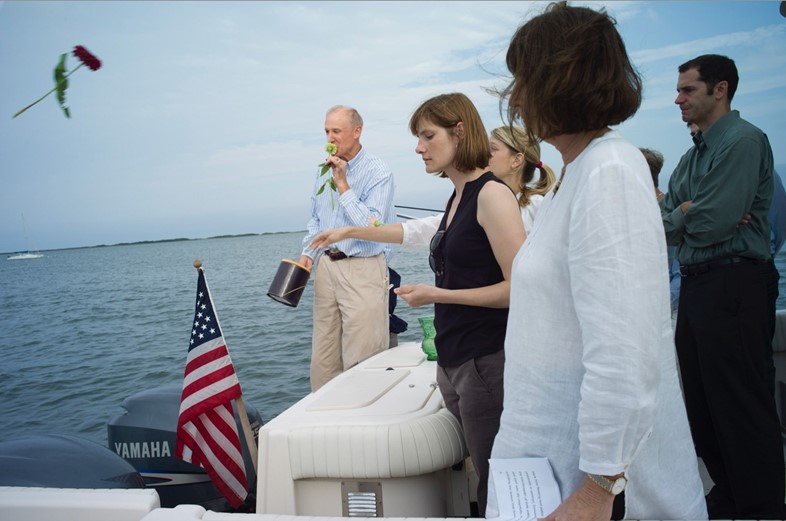
Maggie, Tuscany 2020
“At the very end of the book is a picture right here in the garden. My wife Maggie is from England originally and is a terrific English gardener. This place that we rent was only gravel – it had no grass, no trees, no bushes, nothing. The place itself was lovely, and during the time we’ve been here now, Maggie has built an incredible garden as a gift for the people who own it. One night on the full moon she went out in her nightgown and was standing there. Right in front of her is a stone garden with these wonderful leaping flowers. I made this as a kind of coda to the book so that the last picture would be of Maggie in her garden of flowers under the moonlight.”

Wild Flowers by Joel Meyerowitz is published by Damiani.
